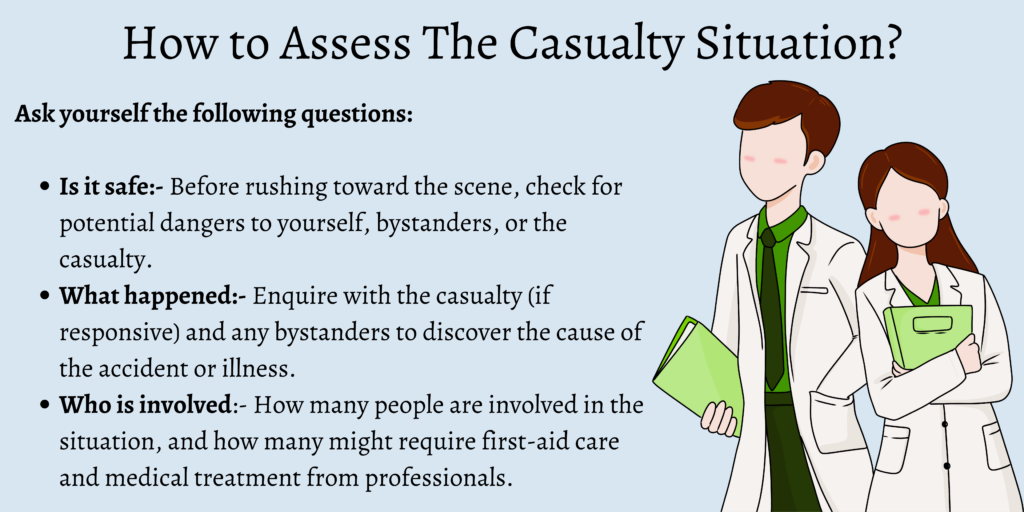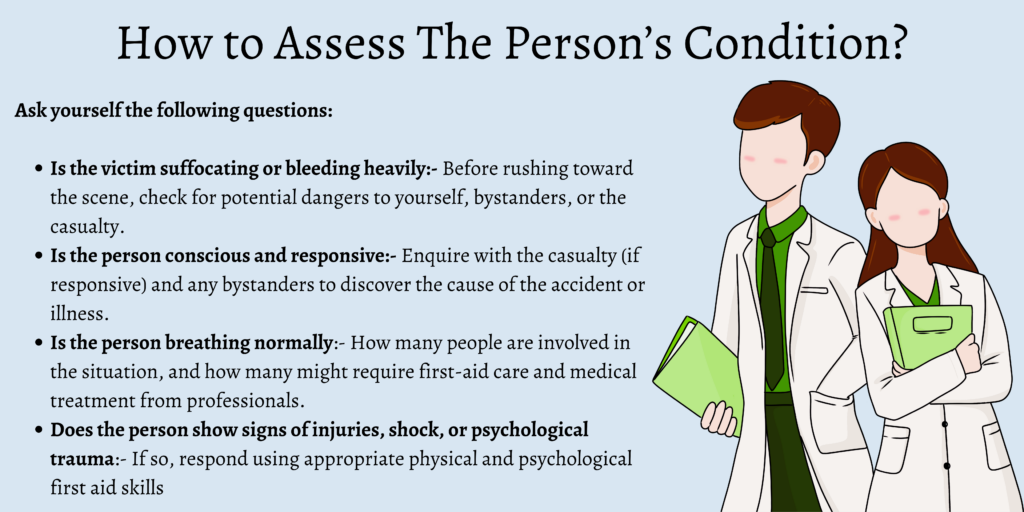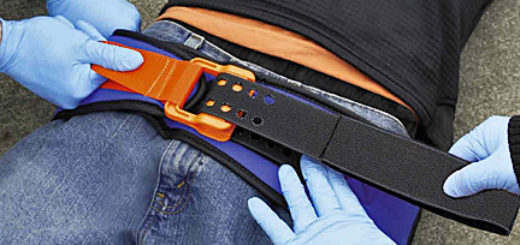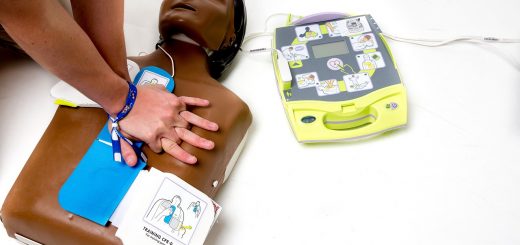The Four Steps of First Aid
First aid is the immediate medical assistance given to an ill or injured person until professional help arrives to take over.
First aid is necessary for both minor and serious injuries and illnesses. By providing the appropriate care, first aiders help to preserve life, stabilize a person’s condition, or promote their recovery. You may be required to step in and assist a casualty in many situations. But whichever scenario you are faced with, it’s important to remember the four basic steps to performing emergency first aid.
These four first aid steps are:
- Assess
- Plan
- Implement
- Evaluate
In this blog post, we’ll take a closer look at the four basic first aid steps so that you can feel confident and prepared to implement them in an emergency.
Step 1: Assess
Before taking action, it’s crucial to perform a quick and calm assessment. Assess the situation for safety and gather information about what happened and who may need help.
Assess The Situation
Ask yourself the following questions:
- Is it safe?
Before rushing toward the scene, check for potential dangers to yourself, bystanders, or the casualty. For example, in the case of a road traffic accident, is the casualty located in the middle of a busy highway? If so, be sure to check for oncoming traffic before approaching, and move them only if remaining where they are could cause more harm. Have a bystander block traffic while you assist the person and assess their injuries.
If the situation is too dangerous, stay back and await assistance from the emergency services. Trying to intervene could result in you becoming injured. It will add more pressure on medics when they arrive, resulting in poorer outcomes for everyone involved.
While assessing the safety of a situation, consider any Personal Protective Equipment (PPE) that may be available, such as gloves, and wear them accordingly.
- What happened?
Enquire with the casualty (if responsive) and any bystanders to discover the cause of the accident or illness. For example, if a person is lying on the ground, were they hit by another person or object, or have they collapsed due to a medical condition?
- Who is involved?
How many people are involved in the situation, and how many might require first-aid care and medical treatment from professionals? Are there any older people, children, or other vulnerable individuals involved?
Assess the Person’s Condition
Ask yourself the following questions:
- Is the victim suffocating or bleeding heavily?
If this is the case, act immediately and appropriately to preserve life and stabilize their condition.
- Is the person conscious and responsive?
If so, reassure them and help them stay calm. Ask for their consent to perform a first aid assessment, and try to gather more information about their condition.
- Is the person breathing normally?
Listen to and observe the casualty to check the quality of their breathing and identify any potential blockages or damage to their airway.
- Does the person show signs of injuries, shock, or psychological trauma?
If so, respond using appropriate physical and psychological first aid skills.
Step 2: Plan for Interventions
After a quick assessment of the casualty and the situation, call for help straight away if needed. Call 911 (or your national equivalent) if the casualty is in immediate danger. In less serious situations, it may be more appropriate to locate a medic (such as an on-site nurse or doctor) or phone the patient’s doctor.
If other bystanders are present, check to see if anyone has any first aid or medical training.
Once emergency services have been contacted, plan what first aid interventions are needed until professional help arrives.
- Conduct an initial or primary assessment of the casualty.
Please read our blog post here for a complete and detailed lesson on conducting a primary assessment.
- Determine how much help you can give based on what you know and what skills you have.
If the patient is unconscious, the steps above should be completed as quickly as possible. It would be best if you began administering chest compressions immediately.
- Ensure your ongoing safety as a rescuer
Never put yourself at risk of harm by administering first aid.
Step 3: Implement First Aid
Now that you have assessed the situation and planned for interventions, it’s time to act on them and begin administering first aid.
- Based on the initial assessment, give first aid for life-threatening emergencies and specific injuries.
If more than one casualty is present, use the findings of your initial assessment to decide who needs the most urgent attention. For example, if one person has a suspected broken arm and another is unresponsive or unconscious, treat the unresponsive or unconscious casualty as a priority.
- If emergency services are arriving very soon, do not splint injuries.
Splints are used to immobilize fractures and broken bones, helping to prevent further damage. However, if medical help is soon to arrive, this task is best left to the professionals.
- Talk to the person and give psychological first aid.
Reassure the victim about their condition and what you do to help them. This kind of dialogue would help calm the casualty and distract them from their injury for a short while. If the person is conscious and responsive, administer psychological first aid as necessary until medics arrive. For a detailed guide on how to give psychological first aid, click here.
- If necessary, prepare the person for transportation.
Once all first aid has been administered, help to prepare the person to board an ambulance or other rescue vehicle. However, please do not move the casualty unless it is safe. Please explain what will happen next, and, with their consent, gather personal belongings so they are ready to go when the transport arrives.
- Maintain safety and wait for assistance.
Your number one priority is always your safety. Only remain with the casualty and administer first aid if it is safe. Otherwise, wait in a secure area for the emergency services to arrive.
Step 4: Evaluate The Situation
Always stay with the casualty until professional help arrives. If all necessary first aid has been done, evaluate your actions and reassess to ensure everything has been noticed.
- Check that medical or professional assistance will arrive soon.
If medical help has taken longer than expected, call the emergency number again or have another bystander call to ensure they are on their way.
- Check that the scene remains safe.
If not, consider moving the person as carefully as possible with help from bystanders or other rescuers. Use your best judgment to conduct a risk assessment for moving the patient vs. staying put.
For example, if a spine or neck injury is suspected and the casualty is in the middle of a busy road, only move them if their life is in danger. If traffic is stopped, remain where you are and do not attempt to move the casualty.
- Recheck the actions carried out after the initial assessment.
An emergency first aid situation can be stressful. In a real-life scenario, missing crucial steps or forgetting key actions you learned during training is easy. So, if you are still waiting for medics to arrive, recheck the actions you carried out in Step 3 to ensure everything has been noticed.
- Ensure that any bandages are still in place and bleeding has stopped.
If bleeding continues, do NOT remove existing dressings. Add more dressings and apply pressure to the wound.
- If the casualty becomes unconscious, follow actions for basic life support (BLS).
Basic Life Support involves maintaining unobstructed airways and assisting a casualty with heart rate and breathing (e.g., CPR) without equipment. Read our in-depth blog post here for more information about BLS and how to perform this lifesaving intervention.
- Hand over the casualty to medical or professional personnel when they arrive.
Share all information you have about the casualty, including:
- What happened?
- Any injuries or abnormalities you found during your assessment.
- How the injury/illness was sustained?
- How long since the injury/illness occurred?
- How long (if at all) has the casualty been unconscious?
- Any interventions you have administered. E.g., wound dressing, splints, CPR, and AED.
Find out which hospital, clinic, or health center will provide care.
Once you have this information, take the necessary steps to inform family and relatives of the casualty’s condition and location.
First Aid Principles
The four principles of first aid management are:
- Stay calm. Do not take risks for yourself, the injured person or any witnesses.
- Manage the situation to give safe access to the person.
- Manage the patient in line with current first aid guidance
- Do things step by step







